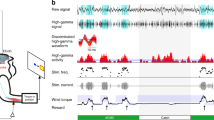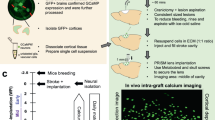Abstract
It has been proposed that the efficacy of neuronal connections is strengthened when there is a persistent causal relationship between presynaptic and postsynaptic activity. Such activity-dependent plasticity may underlie the reorganization of cortical representations during learning, although direct in vivo evidence is lacking. Here we show that stable reorganization of motor output can be induced by an artificial connection between two sites in the motor cortex of freely behaving primates. An autonomously operating electronic implant used action potentials recorded on one electrode to trigger electrical stimuli delivered at another location. Over one or more days of continuous operation, the output evoked from the recording site shifted to resemble the output from the corresponding stimulation site, in a manner consistent with the potentiation of synaptic connections between the artificially synchronized populations of neurons. Changes persisted in some cases for more than one week, whereas the output from sites not incorporated in the connection was unaffected. This method for inducing functional reorganization in vivo by using physiologically derived stimulus trains may have practical application in neurorehabilitation after injury.
This is a preview of subscription content, access via your institution
Access options
Subscribe to this journal
Receive 51 print issues and online access
$199.00 per year
only $3.90 per issue
Buy this article
- Purchase on Springer Link
- Instant access to full article PDF
Prices may be subject to local taxes which are calculated during checkout





Similar content being viewed by others
References
Buonomano, D. V. & Merzenich, M. M. Cortical plasticity: from synapses to maps. Annu. Rev. Neurosci. 21, 149–186 (1998)
Sanes, J. N. & Donoghue, J. P. Plasticity and primary motor cortex. Annu. Rev. Neurosci. 23, 393–415 (2000)
Monfils, M. H., Plautz, E. J. & Kleim, J. A. In search of the motor engram: motor map plasticity as a mechanism for encoding motor experience. Neuroscientist 11, 471–483 (2005)
Nudo, R. J., Milliken, G. W., Jenkins, W. M. & Merzenich, M. M. Use-dependent alterations of movement representations in primary motor cortex of adult squirrel monkeys. J. Neurosci. 16, 785–807 (1996)
Kleim, J. A., Barbay, S. & Nudo, R. J. Functional reorganization of the rat motor cortex following motor skill learning. J. Neurophysiol. 80, 3321–3325 (1998)
Nudo, R. J., Wise, B. M., SiFuentes, F. & Milliken, G. W. Neural substrates for the effects of rehabilitative training on motor recovery after ischemic infarct. Science 272, 1791–1794 (1996)
Raineteau, O. & Schwab, M. E. Plasticity of motor systems after incomplete spinal cord injury. Nature Rev. Neurosci. 2, 263–273 (2001)
Hebb, D. O. The Organization of Behaviour: a Neuropsychological Theory (Wiley, New York, 1949)
Iriki, A., Pavlides, C., Keller, A. & Asanuma, H. Long-term potentiation in the motor cortex. Science 245, 1385–1387 (1989)
Hess, G., Aizenman, C. D. & Donoghue, J. P. Conditions for the induction of long-term potentiation in layer II/III horizontal connections of the rat motor cortex. J. Neurophysiol. 75, 1765–1778 (1996)
Racine, R. J., Chapman, C. A., Trepel, C., Teskey, G. C. & Milgram, N. W. Post-activation potentiation in the neocortex. IV. Multiple sessions required for induction of long-term potentiation in the chronic preparation. Brain Res. 702, 87–93 (1995)
Nudo, R. J., Jenkins, W. M. & Merzenich, M. M. Repetitive microstimulation alters the cortical representation of movements in adult rats. Somatosens. Mot. Res. 7, 463–483 (1990)
Monfils, M. H., VandenBerg, P. M., Kleim, J. A. & Teskey, G. C. Long-term potentiation induces expanded movement representations and dendritic hypertrophy in layer V of rat sensorimotor neocortex. Cereb. Cortex 14, 586–593 (2004)
Shors, T. J. & Matzel, L. D. Long-term potentiation: what’s learning got to do with it?. Behav. Brain Sci. 20, 597–614 (1997)
Markram, H., Lubke, J., Frotscher, M. & Sakmann, B. Regulation of synaptic efficacy by coincidence of postsynaptic APs and EPSPs. Science 275, 213–215 (1997)
Dan, Y. & Poo, M. Spike timing-dependent plasticity of neural circuits. Neuron 44, 23–30 (2004)
Mavoori, J., Jackson, A., Diorio, C. & Fetz, E. E. An autonomous implantable computer for neural recording and stimulation in unrestrained primates. J. Neurosci. Methods 148, 71–77 (2005)
Jackson, A., Moritz, C. T., Mavoori, J., Lucas, T. H. & Fetz, E. E. The Neurochip BCI: Towards a neural prosthesis for upper limb function. IEEE Trans. Neural Sys. Rehab. Eng. 14, 187–190 (2006)
Jackson, A., Mavoori, J. & Fetz, E. E. Correlations between the same motor cortex cells and arm muscles during a trained task, free behaviour and natural sleep in the macaque monkey. J. Neurophysiol. (in the press).
Maynard, M. E. et al. Neuronal interactions improve cortical population coding of movement direction. J. Neurosci. 19, 8083–8093 (1999)
Ito, M. & Kano, M. Long-lasting depression of parallel fibre-Purkinje cell transmission induced by conjunctive stimulation of parallel fibres and climbing fibres in the cerebellar cortex. Neurosci. Lett. 33, 253–258 (1982)
Huang, Y-Y., Pittenger, C. & Kandel, E. R. A form of long-lasting, learning-related synaptic plasticity in the hippocampus induced by heterosynaptic low-frequency pairing. Proc. Natl Acad. Sci. USA 101, 859–864 (2004)
Baranyi, A. & Feher, O. Synaptic facilitation requires paired activation of convergent pathways in the neocortex. Nature 290, 413–415 (1981)
Jankowska, E., Padel, Y. & Tanaka, R. The mode of activation of pyramidal tract cells by intracortical stimuli. J. Physiol. (Lond.) 249, 617–636 (1975)
Jackson, A., Gee, V. J., Baker, S. N. & Lemon, R. N. Synchrony between neurons with similar muscle fields in monkey motor cortex. Neuron 38, 115–125 (2002)
Fetz, E. E., Toyama, K. & Smith, W. A. in Cerebral Cortex Vol. 9 (ed. Peters, A.) 1–47 (Plenum, New York, 1991)
Hatsopoulos, N. G., Ojakangas, C. L., Paninski, L. & Donoghue, J. P. Information about movement direction obtained from synchronous activity of motor cortical neurons. Proc. Natl Acad. Sci. USA 95, 15706–15711 (1998)
Fregnac, Y., Shulz, D., Thorpe, S. & Bienenstock, E. A cellular analogue of visual cortical plasticity. Nature 333, 367–370 (1988)
Ahissar, E. et al. Dependence of cortical plasticity on correlated activity of single neurons and on behavioral context. Science 257, 1412–1415 (1992)
Mu, Y. & Poo, M. Spike timing-dependent LTP/LTD mediates visual experience-dependent plasticity in a developing retinotectal system. Neuron 50, 115–125 (2006)
Stickgold, R. & Walker, M. P. Sleep and memory: the ongoing debate. Sleep 28, 1225–1226 (2005)
Prochazka, A., Mushahwar, V. K. & McCreery, D. B. Neural prostheses. J. Physiol. (Lond.) 533, 99–109 (2001)
Plautz, E. J. et al. Post-infarct cortical plasticity and behavioral recovery using concurrent cortical stimulation and rehabilitative training: a feasibility study in primates. Neurol. Res. 25, 801–810 (2003)
Khedr, E. M., Ahmed, M. A., Fathy, N. & Rothwell, J. C. Therapeutic trial of repetitive transcranial magnetic stimulation after acute ischemic stroke. Neurology 65, 466–468 (2005)
Acknowledgements
We thank C. Kirby for technical help, F. Miles for development of the Neurochip stimulator, L. Shupe for programming, and S. Perlmutter for advice. This work was supported by grants from the National Institutes of Health, the Office of Naval Research and the University of Washington Royalty Research Fund. Author Contributions A.J. and E.E.F. conceived and designed the experiment. J.M. designed the Neurochip electronics. A.J. and J.M. performed the experiments. A.J. and E.E.F. wrote the paper.
Author information
Authors and Affiliations
Corresponding author
Ethics declarations
Competing interests
Reprints and permissions information is available at www.nature.com/reprints. The authors declare no competing financial interests.
Supplementary information
Supplementary Table 1
Supplementary material details surgical procedures, the Neurochip electronics and additional methods. Supporting data includes documentation of cell firing patterns, further examples of conditioning experiments and a table summarising all sessions. (PDF 620 kb)
Rights and permissions
About this article
Cite this article
Jackson, A., Mavoori, J. & Fetz, E. Long-term motor cortex plasticity induced by an electronic neural implant. Nature 444, 56–60 (2006). https://doi.org/10.1038/nature05226
Received:
Accepted:
Published:
Issue Date:
DOI: https://doi.org/10.1038/nature05226
This article is cited by
-
Closing the loop in psychiatric deep brain stimulation: physiology, psychometrics, and plasticity
Neuropsychopharmacology (2024)
-
Agar-based optical sensors for electric current measurements
Scientific Reports (2023)
-
Increasing associative plasticity in temporo-occipital back-projections improves visual perception of emotions
Nature Communications (2023)
-
The impact of closed-loop intracortical stimulation on neural activity in brain-injured, anesthetized animals
Bioelectronic Medicine (2022)
-
Dopaminergic dysfunction and excitatory/inhibitory imbalance in treatment-resistant schizophrenia and novel neuromodulatory treatment
Molecular Psychiatry (2022)
Comments
By submitting a comment you agree to abide by our Terms and Community Guidelines. If you find something abusive or that does not comply with our terms or guidelines please flag it as inappropriate.



